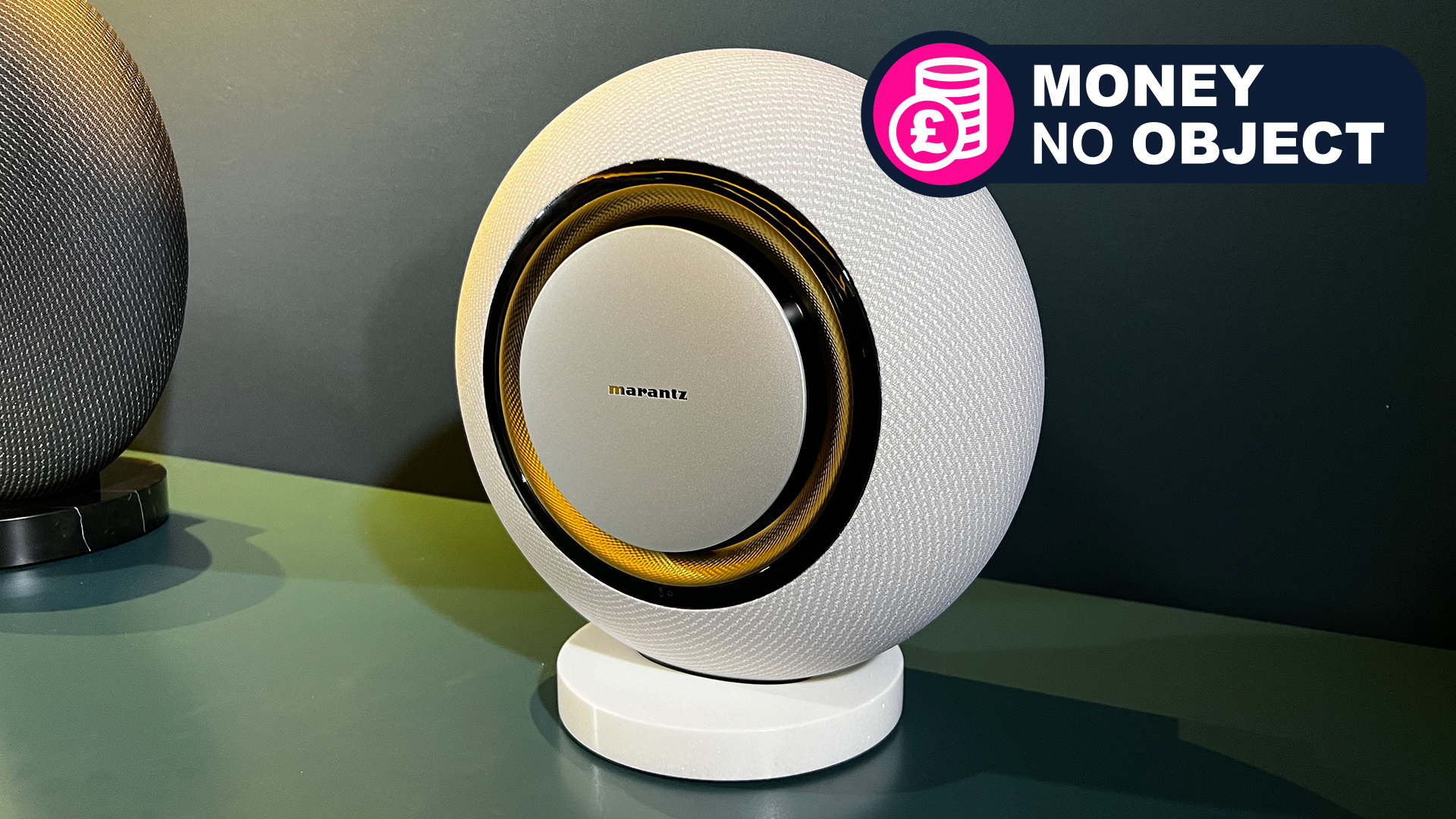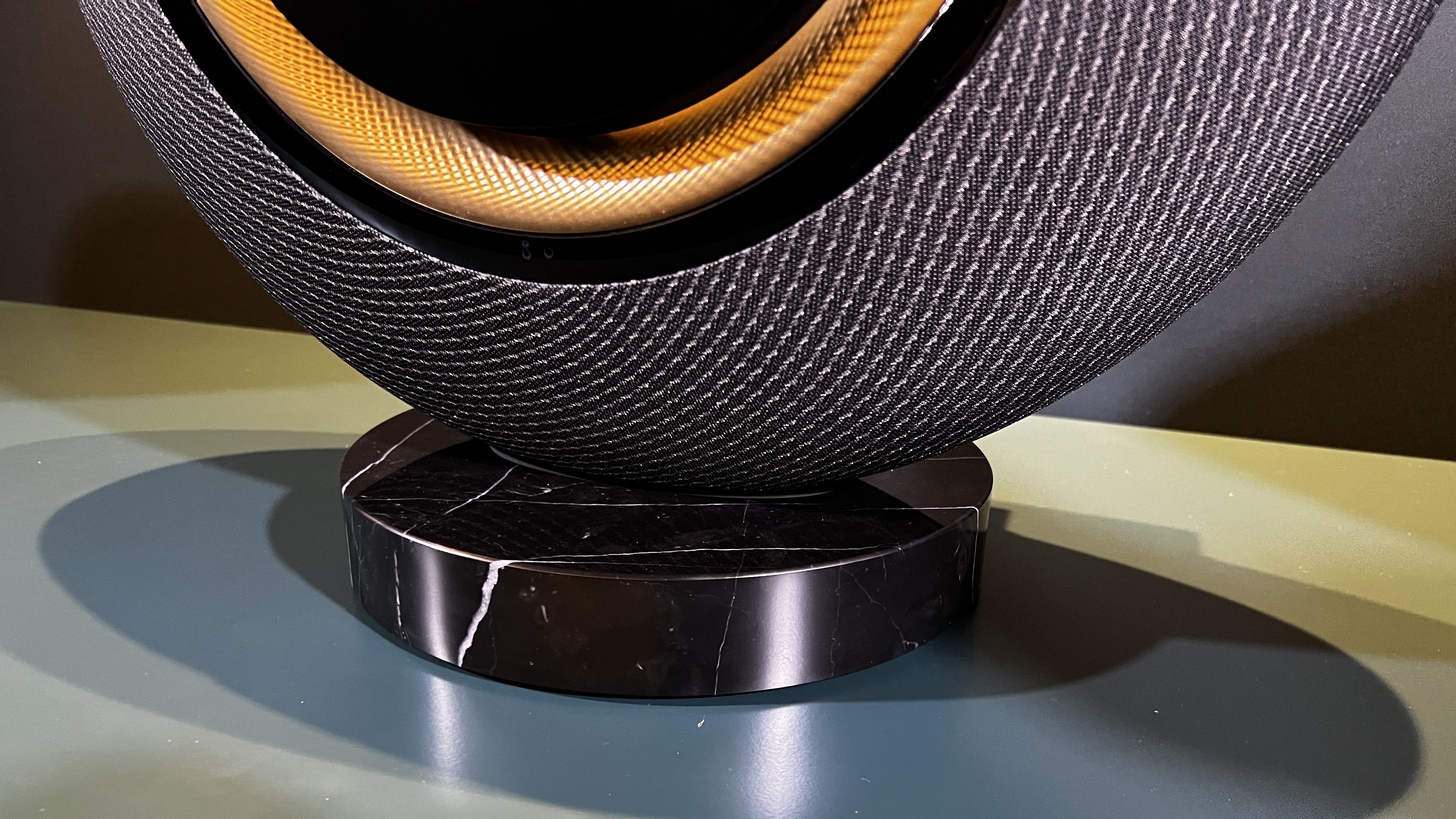Marantz Grand Horizon is easily the best one-box wireless speaker I've heard – but for this price, it'd better be
Money No Object: Incredibly expansive and deep sound from a luxury speaker

Marantz, the Japanese hi-fi stalwart, has just announced its first all-in-one wireless speakers: the Horizon and the larger, beefier Grand Horizon. They're big, circular beasts made with a luxury look and materials, and packing in huge amplification power and a lot of speakers. And they'll come at a high price when they launch in January 2025, with the smaller Horizon costing $3,500 / £3,250, and the Grand Horizon costing $5,500 / £5,250. (No Australian pricing has been confirmed yet.)
The circular design works in combination with the speaker arrangement, which is filled with multi-angled drivers to deliver Dolby Atmos audio, as well as expansive stereo sound. The Grand Horizon is equipped with eight drivers in total, comprising three tweeters (firing up, left and right), four mid-range drivers (firing up-left, up-right, down-left and down-right), and one "Gravity" bass driver in the center. That's all backed up by 860W of peak amplification power. This is contained in a 493 x 255 x 529.2mm (19.41 x 10.04 x 20.83 inch) body, with a built-in plinth made of marble.
The smaller Horizon is 364 x 210 x 387.5mm (14.33 x 8.27 x 15.26 inch), and so features fewer speakers. Here, you've got two tweeters and three mid-range drivers, and the Gravity bass driver – all with up to 745W of peak power. Unlike the Grand Horizon, there will be an optional tripod stand for the smaller Horizon, which costs a cool $700 / £650. Both models can be wall-mounted, though we don't know when these brackets will be available yet (engineers are working on how to deal with the pressure levels these things generate).
For connections, you've got a stereo RCA in, optical, HDMI eARC and USB-C. The HEOS wireless platform provides Bluetooth and Wi-Fi as well, with support for AirPlay 2 and Spotify Connect (in case you are, inexplicably, using this with Spotify). Various streaming services can play on it directly via the app.
In comparison to the other best wireless speakers, they're basically the Charizard to the Sonos Era 300's Charmander – bigger, stronger, more elite – and backed by the sound engineering that Marantz is famous for.
I got to hear them in person, and I can tell you that the Grand Horizon in particular is easily the best-sounding one-box speaker I've ever heard. But I also heard something else shortly after that put that giant price into sharp perspective.

Huge sound from huge speakers
I listened to the Grand Horizon in a sizable room (though probably not an unrealistic size of room for the kind of audience likely to buy this) at around 75% volume, and it provided the biggest, most enveloping sound I've heard from a single speaker.
Sign up for breaking news, reviews, opinion, top tech deals, and more.
The sound is highly detailed, with lots of nuance and range to it. It can sound sweet and clear when it should, but equally you can pick up every croak in a gravelly voice. It manages to deliver great energy and rhythm while still being incredibly revealing too – this isn't made to be plain and analytical, but it's still a realistic and carefully-handled listen.
Bass is luxuriously deep and can be roaring – at this volume, it feels a little like having your own club system. But it’s 100% precise and controlled, and doesn't drag the sound down into low frequencies – it carefully adds resonance power to acoustic instruments to make them convincing, weighty and realistic in a rare way. In the demo, the bass didn't really transfer into the floor either, so you can ramp it up for chest pushing fun without it feeling ridiculous elsewhere in the house.
In stereo, the sound is nicely dispersed and broad while still feeling deliberate and specific. The speaker then does an interesting job with really spatial tracks – you can hear a halo of music spreading over the wall around it, though it still sounds like the center of everything.
There's clear positioning happening, and though obviously this won't be around you in 3D space the way it would be from a Dolby Atmos home theater system, it provides a clear sense that different sounds in the mix are coming from a panorama in front of you.
(I should note here that, at the moment, Dolby Atmos will only work over HDMI eARC, but streaming support is planned for later.)

I listened to this demo using 44kHz, 16-bit tracks, in the Grand Horizon's Auto sound mode. This is the default, and it's considered to be a balanced mode, but you can also choose Sound Master mode, which is considered more of a 'pure' mode, tuned by Marantz music maestro Yoshinori Ogata, and will give you sound that's a little more forward and audiophile-friendly.
There's also a 'My Mirage' mode, which is a customizable option. You don't adjust treble or bass; you adjust 'Warmth', 'Spaciousness' and 'Clarity'.
Marantz suggests adjusting it based on use cases – if you always sit in the same position in front of it, maybe you close down the Spaciousness option, and treat the rest to your taste. But if you use it in a big room for a party, you want the same sound profile everywhere in it, so you go full on the Spaciousness, which should achieve that. I didn't try these out, though.

The problem is slick separates
I came away from my time with the Grand Horizon feeling totally impressed by the sound for a single-unit speaker, though given the size, price and the amount of engineering involved, that's not really a surprise.
The problem that the Grand Horizon has, though, was highlighted to me shortly after I heard it, when I went to a different Marantz demo. Here was Marantz's new M1 streaming amp ($1,000 / £899) paired with a set of Bowers & Wilkins 607 S3 speakers ($899 / £549), and the scale, power and quality of the music was extremely close to what I heard from the Horizon.
For a third of the price of the Grand Horizon (and in a room that was not very optimized for testing speakers) I found myself thinking that this combo delivered expansiveness and detail to rival the Grand Horizon, and with more than enough power for most rooms. Sure, you won't get the Dolby Atmos positioning effect, but that's a nice to have, far from an essential.
This setup honestly wouldn't be much harder to accommodate in a room than the Grand Horizon – it's just that you'd have to deal with some speaker cabling, and it's fair that some people would want to avoid that.
You also don't get the striking design of the Grand Horizon, with its ring of LEDs that lights up when you approach (and indicates the volume level in a circle), its lovely Midnight Sky (black) and Moon Ray (off-white) finishes, and cool EcoFiber covering. The Moon Ray is made up of different shades, and even a sparkly finish to the fabric.
The Grand Horizon is incredibly impressive, and if you fit the 'money no object' brief of these articles and want a single speaker with stunning sound, I would happily recommend it – but I came away from my demos scheming about creating a new amp and speakers setup, not planning on how I could afford a Horizon.
The Horizon and Grand Horizon will be released on January 14, 2025.
You might also like…
- Bowers & Wilkins updates its iconic 2007 Zeppelin wireless speaker with a Pro edition
- Bose's new Bluetooth speaker looks stylish and portable
- Edifier D32 review: a retro-look wireless speaker that supplies detailed audio

Matt is TechRadar's Managing Editor for Entertainment, meaning he's in charge of persuading our team of writers and reviewers to watch the latest TV shows and movies on gorgeous TVs and listen to fantastic speakers and headphones. It's a tough task, as you can imagine. Matt has over a decade of experience in tech publishing, and previously ran the TV & audio coverage for our colleagues at T3.com, and before that he edited T3 magazine. During his career, he's also contributed to places as varied as Creative Bloq, PC Gamer, PetsRadar, MacLife, and Edge. TV and movie nerdism is his speciality, and he goes to the cinema three times a week. He's always happy to explain the virtues of Dolby Vision over a drink, but he might need to use props, like he's explaining the offside rule.